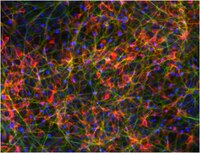GF003 Sigma-AldrichFibroblast Growth Factor basic Protein, Human recombinant
The Fibroblast Growth Factor-basic (FGF-b) is a heparin binding growth factor which stimulates the proliferation of a wide variety of cells including mesenchymal, neuroectodermal & endothelial cells.
More>> The Fibroblast Growth Factor-basic (FGF-b) is a heparin binding growth factor which stimulates the proliferation of a wide variety of cells including mesenchymal, neuroectodermal & endothelial cells. Less<<Recommended Products
Overview
| Replacement Information |
|---|
Key Specifications Table
| Key Applications | Species | Source | Purity |
|---|---|---|---|
| CULT, Cult | Human | expressed in E. coli | Greater than 95% by SDS-PAGE. Endotoxin level is less than 0.1 EU per μg of FGF-b. |
| References |
|---|
| Product Information | |
|---|---|
| HS Code | 2937 19 90 |
| Presentation | Lyophilized from a 0.7 mg/mL solution in 5mM Tris, pH 7.6 with 150 mM NaCl. |
| Quality Level | MQ100 |
| Physicochemical Information |
|---|
| Dimensions |
|---|
| Materials Information |
|---|
| Toxicological Information |
|---|
| Safety Information according to GHS |
|---|
| Safety Information |
|---|
| Packaging Information | |
|---|---|
| Material Size | 50 µg |
| Transport Information |
|---|
| Supplemental Information |
|---|
| Specifications |
|---|
| Global Trade Item Number | |
|---|---|
| Catalog Number | GTIN |
| GF003 | 08436037124808 |
Documentation
Fibroblast Growth Factor basic Protein, Human recombinant SDS
| Title |
|---|
Fibroblast Growth Factor basic Protein, Human recombinant Certificates of Analysis
Technical Info
| Title |
|---|
| A Comparative Analysis of Human Embryonic Stem Cells Cultured in a Variety of Media Conditions |
| Accumax Dissociation Reagent for the Serial Passaging of Human Embryonic Stem Cells |
Data Sheet
| Title |
|---|
| RECOMBINANT HUMAN FIBROBLAST GROWTH FACTOR-BASIC |
Newsletters / Publications
| Title |
|---|
| Cellutions Newsletter: 2007, Volume 1 |
| Cellutions Newsletter: 2008, Volume 1 |
| Cellutions Newsletter: 2008, Volume 3 |








